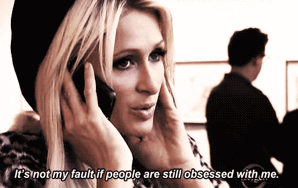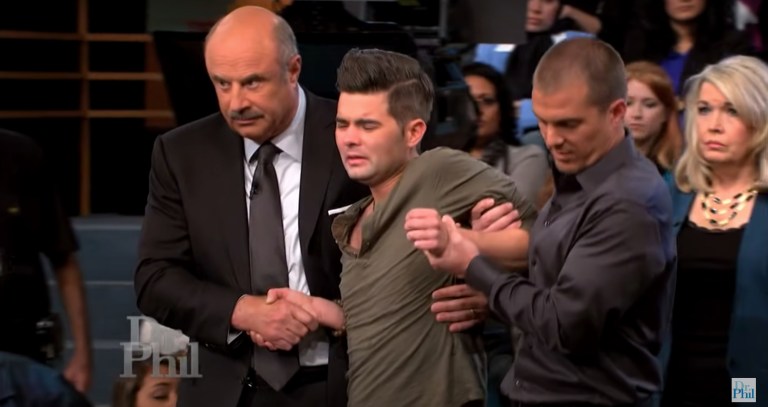What Paris Hilton Says About Our Culture Of Slut-Shaming
The more we shame her, the bigger she gets. At this rate, she’ll be the biggest “slut” we’ve ever seen.
By ![]() Nico Lang
Nico Lang

In a weird way, I came of age in the Paris Hilton generation, when the wealthy socialite and her hoard of louboutin-wearing celebutantes stormed the media in matching tans. Paris Hilton came from nowhere to conquer the tabloids, creating a media frenzy for just existing — whether it was walking her toy dog or going out to clubs. Most famous people we expect to perform for our pleasure — by acting in a film or contributing to the entertainment cycle — but Paris didn’t do anything except be wealthy, the daughter of a billionaire. Fame was the spectacle.
However, it wasn’t just wealth that made Paris famous. We all know how she got there: a sex tape. Titled “1 Night in Paris,” footage of her getting intimate with her boyfriend leaked onto the internet in 2004, a video she sued to try to stop from getting out. Hilton claimed that she was “out of it” and didn’t know what she was doing during the taping, which led to a collective shrug from her ex, the married, much older Rick Salomon, and the public. The video became a smash hit, the number-one selling porn title for two years straight. Paris Hilton was suddenly the biggest porn star in the world — without her consent.
Paris and that tape changed what it means to be famous, and as Dr. Gail Dines recently suggested, that fame changed her. In a talk on the effects of porn culture on young women that the professor gave at the Nova Scotia Women’s Summit, Dines suggests that Hilton’s infamous sex tape had a deleterious effect on her psyche and her public persona changed accordingly. Although we’re quick to shame, mock or dismiss Hilton, Dines asks us to put ourselves in her shoes and see things from her perspective. In a culture where we’re quick to judge, it’s surprisingly hard to do.
As Dr. Gail Dines instructs, imagine you’re “nineteen years old and that sex tape is circulating everywhere.” Dines continues,
“Just think for a moment what that must have felt like. And then as most women who are traumatized, there are two choices: You can run and hide and never ever come out again. Or you decide, in a pathological way, to embrace that trauma and “own” it as your own. So what she said is: “If you’re going to call me a slut, then guess what? I’m going to be the best fucking slut you’ve ever met in your life. Which is, by the way, a traumatic response to conditions that are out of your control.”
This reminds me of the debate over other celebrities who have experienced trauma in the public eye: Britney Spears, Amanda Bynes and Kristen Stewart. Stewart’s 2012 cheating scandal led to her fleeing from the public eye, and she’s been largely in hiding for the past year. This is what happens when you’re constantly told everyone hates you. However, Amanda Bynes’ battle with mental illness has become increasingly public, shared and re-tweeted as a social media commodity. As Britney put it on her 2008 hit, “Womanizer,” the idea is: “You say I’m crazy/I got your crazy.” You can give the public exactly what they want, performing their expectation of your breakdown. It’s press, after all.
Although Stewart’s sex scandal has largely taken place behind closed doors, Britney and Paris Hilton shoved their traumas in America’s collective face like a wide-open beaver. Hilton began intentionally trolling the paparazzi, not wearing underwear when she expected to be photographed, a commando trend that surprisingly caught on. Ms. Hilton knew why the paparazzi were interested in her (“Hey, you’re the girl with the sex tape! Give me a photo!”) so she gave them the commodity they were really looking for.
A picture says a thousand words, and in Hilton’s case, that undercurrent is devastating. Being a teenager is difficult enough without having to worry that people are masturbating to you at their laptop or that your friend’s Dad has seen you naked. The entire world knew Paris Hilton’s vagina before they got to know her, and I find it interesting that on The Simple Life, the reality show that debuted not long after the tape was released, she chose to play a character — not herself. The Paris we saw on television was staged for the cameras, as the program played into what we thought she was like: just another spoiled rich girl. She gave us someone to hate.
The show, of course, was a huge hit. If anything, Paris Hilton knows how to get attention.
But in real life, Hilton and Richie were on good terms with the Tennessee family with whom they stayed, the Seberts. Pepe Sebert, the matriarch of the family, was a former hit singer-songwriter who moved her children outside of Nashville after being a single mother in L.A. proved difficult. However, you see little of Sebert’s past onscreen either; she’s presented as a typical Mom, just like any other, instead of a former rock star. Sebert’s daughter became such good friends with Hilton and Richie that she started her own music career. We, of course, know her know now as Ke$ha. It’s further proof you can’t believe everything you see on TV.
Hilton has now been famous for such a long time that I highly doubt she thinks about the calculated simulacra that is her own image, as fakeness is part of the fame game. It’s The Hyperreal Life. However, it matters for us who have grown up with Hilton and internalized all of these messages about what it means to be female, have a vagina and be hated for it. Overt expressions of one’s sexuality come with grave consequences for young women — and we can see the same trends in Miley Cyrus’ career. Miley Cyrus was widely shamed for being a slut, and now she won’t put her tongue away. What was “Wrecking Ball” video if not a giant middle finger to everyone who shamed her?
This trauma not only defines careers but our relationships with those celebrities, where we continue to relive those traumas by perpetuating cycles of misogyny. Hilton and Cyrus are two of the most widely hated celebrities in America, but they’re also two of the most famous. Paris’ Hilton defined the second half of the last decade, a ubiquitous pop cultural presence, and Miley Cyrus is becoming inescapable, whether it’s on magazine covers or the radio. “Wrecking Ball” has been number-one for two weeks, as people continue to hate-click the music video, driving up her Billboard Chart Points. The more we shame her, the bigger Miley gets — and the more that hate changes us.
At this rate, she’ll be the biggest “slut” we’ve ever seen. ![]()




